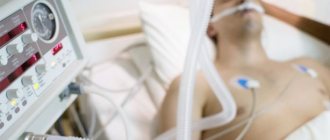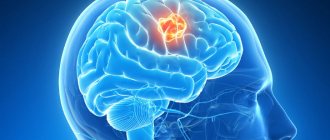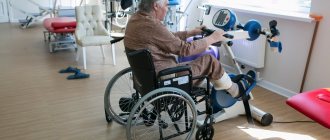Grounds for extradition
Stroke in medical terminology refers to a group of clinical syndromes that develop as a result of a decrease or cessation of blood supply to the brain.
If an acute cerebrovascular accident (hereinafter - ACVA) caused a persistent neurological disorder, then it is classified as a stroke, and a working person who has suffered it needs a certificate of incapacity for work .
The need for a sick leave certificate in this case is obvious and the legal basis for its issuance is the simultaneous presence of the following factors:
- diagnosed by a doctor at a licensed medical institution, which resulted in a persistent neurological disorder (stroke);
- a person who has suffered a stroke is a party to labor relations as an employee in accordance with the Labor Code of the Russian Federation;
- the sick person is insured in the compulsory health insurance system.
Important! Stroke is one of the main causes of disability in the population: 70-80% of stroke survivors become disabled, and about 30% of them require constant care from others.
Maximum duration of sick leave - how many days can you stay for treatment?
How long can you stay on sick leave? How many days are they issued for? During outpatient treatment, the doctor can open a sick leave for no more than 15 calendar days , and if it is extended, a special medical commission is created, which decides the future fate of the employee.
IMPORTANT! In case of long-term (more than 12 months) or severe course of the disease, as well as persistent loss of function of organs and limbs, the doctors of the medical commission refer the person for a medical and social examination, where disability is usually determined.
How many days do they stay on paid b/l?
The approximate deadlines for issuing a certificate of incapacity for various types of stroke are enshrined in the Recommendations of the Ministry of Health of Russia No. 2510/9362-34 dated August 20, 2000 and are:
| Type of stroke | Name according to ICD-10 | Number of sick days depending on the severity of treatment |
| Hemorrhagic | Subarachnoid hemorrhage |
|
| Intracerebral hemorrhage |
| |
| Subdural hemorrhage |
| |
| Ischemic | Brain infarction |
|
The indicated periods of sick leave are approximate : the attending physician in each specific case takes an individual approach to determining the duration of the patient’s incapacity for work, guided by the time restrictions of Part 4 of Art. 59 of the Federal Law “On the Fundamentals of Protecting the Health of Citizens in the Russian Federation” (hereinafter referred to as the Federal Law of November 21, 2011 No. 323-FZ), according to which, in the event of an obvious unfavorable prognosis of the disease, no later than 4 months from the date of opening the bulletin, the patient is sent for passing the ITU, and if he refuses the prescribed assessment of disability, the certificate of incapacity for work must be closed.
How long can you stay on sick leave in 2019?
It is clear that then the health of the insured employee comes first, especially since he has every right to sick leave. Sick leave can be issued for temporary disability, but many are interested in the question: how long is it legal to remain on sick leave continuously in 2021? Legislation changes almost every year and is supplemented by a host of important rules and regulations; only an experienced lawyer can keep up with the process.
Back in 2012, a term was established that a regular therapist can indicate on sick leave - 15 days. After 15 days, the patient is obliged to come to the doctor for an appointment at the clinic and confirm the closure of the sheet (if the patient has recovered) or extend the sick leave for another 15 days, i.e. up to 1 month. If after a month the patient is still in unsatisfactory physical condition, a medical commission meets to decide what to do next. If before this the therapist whom the patient visited was seen in a private hospital, he is sent to a state institution for a commission.
We recommend reading: What Documents Are Needed to Return 13 Percent from the Purchase of an Apartment
What affects the duration?
How long the period of disability after a stroke will last depends on many factors:
- type of stroke;
- severity of stroke;
- speed of restoration of impaired functions;
- general state of human health (primarily the cardiovascular system);
- the patient's response to treatment;
- the presence or absence of recurrent hemorrhage (in the case of hemorrhagic stroke) while on sick leave;
- the presence or absence of repeated incoming cerebrovascular accidents;
- the nature of the patient’s work activity.
It should be noted that in most cases, the patient’s condition after a stroke (except for all types of mild stroke and moderate subdural hemorrhage) indicates an unfavorable prognosis in terms of performance and the doctor, guided by Part 4 of Art. 59 of the Federal Law of November 21, 2011 No. 323-FZ, has the right to immediately refer the patient to receive disability.
Sick leave after a stroke
I am asking you for help, I don’t know what to do……..
I was hoping for a lawyer, but everything turns out differently......
After the death of her father, my daughter received an inheritance in the form of a 1/12 share of a 2-room apartment, 1/3 was owned by my wife from her first marriage, and subsequently she gave her share to my daughter. As a result, there were three owners: 5/12 share of my daughter, 5/12 share of my daughter from her first marriage, 2/12 share of my grandmother (this is the mother of the deceased).
The apartment has two isolated rooms; it was not possible to separate it. My daughter and I have lived in this apartment for more than 13 years. (My daughter has been registered here since birth, she is 13 years old).
We already had several ships. The grandmother decided to attack her granddaughters, namely my daughter, she is suing her without ceasing. . The grandmother filed a lawsuit to determine the order of use of the residential premises and to recover the value of the share in the right of ownership of the property that is in shared ownership. The judge hesitated and could not determine the order of use between the 3 owners... Then at the 3rd meeting, the Grandmother brings an updated claim for the recovery of the value of the share in right of ownership of property that is in shared ownership, where she asks to recover jointly and severally from both granddaughters the cost of her share. Everything would be fine, but my daughter is a minor, my income is 6,000 rubles a month, and my daughter from my first marriage is 18 years old and a university student with no income. I did not have the opportunity to hire a lawyer at that time. The judge did not even want to hear a single argument on my part, did not take into account the salary certificate, and made a decision: to collect jointly and severally from my granddaughters (knowing in advance that we would not be able to pay, we have no property) compensation for my grandmother’s share in the amount of ( According to the assessment of the apartment) for its 8 square meters, 460 thousand rubles, but the moment when ownership passes is not specified. It turned out that my grandmother can use this share, rent it out, sell it, I still have to pay for what, it turns out, for air. I file a cassation appeal with the Supreme Court, which leaves the decision unchanged.
The daughter from her first marriage was immediately closed the enforcement proceedings, it remained only with us, because... I am a legal representative and must pay according to the decision of this court. The bailiffs start shaking me, acting as if I stole this money. I had a stroke, with partial paralysis, memory loss, as a result, 7 months of sick leave and group 3 disability. The time to file a supervisory complaint was missed due to illness.
I submit an application for restoration of the terms due to a stroke, the judge who made the first decision refuses to restore the terms, recognizing the stroke as not a valid reason for reinstating the terms. Then again to the Supreme Court, where my sentence was reinstated.
At this time, the grandmother negotiates with the first daughter, she gives her her share, although the apartment has debts, redevelopment in the apartment is not legalized, that girl is also jointly and severally punished by a court decision, it turns out that she cannot pay it off, but gives it to the grandmother.
In the same way, a trial is taking place without my knowledge and participation in the magistrate’s court to determine the procedure for using the apartment, and it also turns out that this share for which I started paying (albeit a very small amount) is again for the use of my grandmother, who wants to sell her 7 /12 (2/12 for this share, according to the court decision, I pay compensation), and the court decision on compensation remains in force. I file a cassation, the hearing takes place in the district court, where the judge again listens to the arguments of only the grandmother’s side and, referring to the decision of the first court, assigns to her 5/12 received from her daughter from her first marriage and 2/12 for which I began to pay, justifying that I have not yet paid the full price, so she has the right to sell her newly formed share of 7/12. My daughter contacted the prosecutor's office for help, where in her statement she asked to stand up for her because... After the stroke, I am not able to do this. The prosecutor's office wrote that they have no right to influence the court's decision. The guardianship department does not come to court hearings. It turns out that my grandmother is selling her room, and the share for which I am already making payments, but I continue to pay, because the bailiffs do not leave me alone. According to the lawyer, I will not be able to overturn the decision of the court that awarded this compensation, even in connection with the newly discovered circumstances. the judge there will consider the same thing.
Result: that after the death of her father, the child found herself in a debt trap (I have not yet started work for health reasons, constant pressure changes, dizziness) I cannot help her pay, the judges take the grandmother’s side without protecting the minor child, do not take into account her interests, the prosecutor’s office and the guardianship authorities don’t care.
Please help, where should we go? What to do? How can I help my daughter get out of debt?
Grounds for extension and possible deadlines
The basis for extending sick leave is the patient’s slow recovery of lost functions and insufficient response to treatment. The specifics of the work of an employee on sick leave are of no small importance.
Attention! The advisability of extending the certificate of incapacity for work within the 4 months established by law is decided by a medical commission, taking into account the specified circumstances.
For patients with ongoing restoration of functions and stable positive dynamics, the decision is predominantly made to continue treatment simultaneously with being on sick leave; otherwise, the most likely decision is to refer them to medical examination to establish the disability group.
How many days of sick leave are given for a stroke?
It is provided if a person needs rehabilitation on an outpatient basis. Rehabilitation period after surgery B/l is issued on the date of discharge from the medical institution. The maximum period of sick leave is 10 days. The duration of the person’s stay in the hospital is added to this time. If the rehabilitation period exceeds 10 days, a medical commission is appointed and a decision is made to extend the b/l. The maximum period is one year.
The maximum duration of b/l is 4 months (with continuous treatment). The maximum duration of sick leave is 5 months (cumulative annual duration). What's next? In theory, after the maximum period of sick leave has expired, a person can open a new sick leave.
Where and who issues a bill of lading?
All types of stroke are the result of severe brain damage , so the person who has suffered it undergoes treatment in a hospital setting, where he receives a certificate of incapacity for work.
Of course, opening a sick leave at a clinic is also possible, but in practice this is not so common.
In accordance with Order of the Ministry of Health and Social Development of Russia dated June 29, 2011 No. 624n, licensed medical institutions have the right to issue certificates of incapacity for work . In addition to general information about the patient, the sick leave must include a two-digit code – “01”, indicating the disease as a general cause of disability.
The procedure for paying for time spent on sick leave is regulated by Federal Law No. 255-FZ of December 29, 2006. Three days of incapacity for work are paid by the employer, and all subsequent days by the Social Insurance Fund.
The amount that an employee will receive directly depends on his total insurance period - the period of employment during which the employer transferred insurance contributions to extra-budgetary funds for him. The longer the total insurance period, the larger the payments.
Note! An employee with less than 1 year of experience will receive the least - 30% of average earnings. An employee for whom contributions to insurance funds have been received for 8 or more years has the right to receive a payment in the amount of 100% of the average salary.
How is a certificate of incapacity for work issued and paid?
A document on temporary incapacity for work can be opened by a hospital doctor (if the patient is hospitalized) or by a local clinic physician (if a person has gone to a therapist with signs of a stroke or has undergone hospital treatment, but is still not feeling well). A certificate of release from work is issued on the day of the person’s visit to the doctor.
Payment for sick leave is carried out taking into account the following factors:
- the person's work experience;
- number of days on sick leave;
- average salary.
People who have worked for less than 8 years are paid a certain percentage of the average salary (about 60-80%) for the last two months. If a person has 8 years of experience or more, then he is entitled to sick pay in the amount of his full earnings.
Thus, a stroke is a serious condition. When it occurs, the person is hospitalized. Hospital stays range from three weeks to two months or more. A person undergoes outpatient treatment from 60 to 100-105 days, depending on the type of pathology. If during this period the ability to work is not restored, then the sick leave is extended.
Blood tests that determine the risk of heart attack and stroke
The blood tests below help determine the risk of developing coronary heart disease, stroke , peripheral vascular disease and, if necessary, prescribe treatment.
Lipoprotein A ( Lp (a)) is a blood protein whose levels indicate an increased risk of heart attack and stroke.
Normal value:
Desired level for adults: no more than 30 mg/dl.
Preparing for the analysis:
Blood is taken for analysis after a 12-hour fast (except for drinking water). To get more accurate results, you should refrain from taking the test for at least two months after a heart attack, surgery, infection, injury, or pregnancy.
Lipoprotein A is a low-density lipoprotein (LDL) that has a protein called apo attached to it. Currently, it is not fully known what function lipoprotein A performs in the body, but it is known that blood levels of lipoprotein A higher than 30 mg/dl increase the risk of developing myocardial infarction and stroke. In addition, high levels of lipoprotein A can lead to the development of fat embolism and increases the risk of developing blood clots.
It is especially important to bring the level of LDL (low-density lipoprotein) to normal if the content of lipoprotein A is high. The causes of high levels of lipoprotein A are kidney disease and some familial (genetic) disorders of lipid metabolism. Apolipoprotein A1 (A p o A1) is the main protein of HDL (high density lipoprotein). Low levels of apolipoprotein A1 indicate an increased risk of early cardiovascular disease. Apo 1 is more often reduced in patients suffering from physical inactivity, obesity, or eating a high amount of fat.
Normal value:
Desired level for an adult: more than 123 mg/dl.
Preparing for the analysis:
Blood should be drawn for testing after a 12-hour fast (excluding drinking water). To get more accurate results, you should refrain from taking the test for at least two months after a heart attack, surgery, infection, injury, or pregnancy.
Apolipoprotein B (a p oB) is the main protein found in cholesterol. ApoB is a better overall marker of cardiovascular risk than LDL, a new study suggests.
Normal value:
Less than 100 mg/dL for low/moderate risk individuals. Less than 80 mg/dL for those at high risk, such as those with cardiovascular disease or diabetes.
Preparing for the analysis:
Blood should be drawn for testing after a 12-hour fast (excluding drinking water). To get more accurate results, you should refrain from taking the test for at least two months after a heart attack, surgery, infection, injury, or pregnancy.
Fibrinogen is a protein found in the blood and involved in the blood clotting system. However, high fibrinogen levels may increase the risk of myocardial infarction and vascular disease.
Normal value:
Less than 300 mg/dl.
Preparing for the analysis:
Blood should be drawn for testing after a 12-hour fast (excluding drinking water). To get more accurate results, you should refrain from taking the test for at least two months after a heart attack, surgery, infection, injury, or pregnancy.
Elevated levels of fibrinogen are more often detected in older patients, in patients with high blood pressure, body weight and LDL. On the other hand, lower levels of fibrinogen are detected in patients who drink alcohol and regularly undergo physical activity. An increase in fibrinogen levels occurs with menopause.
High-sensitivity C-reactive protein (protein) (CRP ) is a protein found in the blood that is called an “inflammatory marker,” meaning its presence indicates an inflammatory process in the body. Inflammation is a normal response to many physical conditions, including fever, injury, and infection. But the inflammatory process, localized in the vessel wall, plays an important role in the initiation and progression of cardiovascular diseases. Inflammation (ie, swelling and damage) of the inner wall of the arteries is an important risk factor for the development of cardiovascular diseases such as atherosclerosis, myocardial infarction, sudden death, stroke, blood clots, and peripheral artery disease.
In the Harvard University Health Study, elevated CRP levels were a more accurate marker of coronary heart disease than cholesterol levels. The study assessed twelve different markers of inflammation in healthy postmenopausal women. After three years, C reactive protein was the strongest predictor of risk. Women in the group with the highest CRP levels were more than four times more likely to die from coronary heart disease or suffer a nonfatal heart attack or stroke.
More recently, the JUPITER (Justification for Statins in Primary Prevention) study showed that statins prevent heart disease and reduce the risk of stroke, heart attack, and death in individuals with normal LDL (bad cholesterol) levels but elevated high-sensitivity C-reactive protein (CRP) levels. ).
While elevated levels of cholesterol, LDL and triglycerides and low HDL are independent risk factors for heart disease, high-sensitivity C-reactive protein provides additional information about the inflammatory process in the arteries that cannot be determined by the lipid spectrum.
Normal value:
Less than 1.0 mg/l = low risk of cardiovascular disease; 1.0 - 2.9 mg/l = intermediate risk of developing cardiovascular diseases; more than 3.0 mg/l = high risk of developing cardiovascular diseases.
CRP levels of 50 mg/L or higher are sometimes detected, but usually CRP levels above 10 mg/L are due to another inflammatory process, such as infection, injury, arthritis, etc.
Therefore, testing should not occur during illness or injury. CRP should be studied to assess the risk of developing cardiovascular disease in apparently healthy individuals who have not had a recent infectious disease or other serious illness. Those patients whose CRP level during the study was above 10 mg/l should be examined to identify the source of the inflammatory process.
Preparing for the analysis:
This test can be performed at any time of the day, without any preparation. The only condition is the absence of acute inflammation.
Myeloperoxidase (MPO) is a marker of the inflammatory process in the arteries. As a result of this process, destruction of atherosclerotic deposits in the vessel wall often occurs, leading to thrombosis. A high level of myeloperoxidase, in combination with other risk factors (CRP, LDL, high blood pressure, excess weight) is an accurate criterion for an increased risk of heart attack, myocardial infarction, sudden death, stroke or peripheral vascular disease, including in apparently healthy people .
Normal value:
Less than 400 microns.
Preparing for the analysis:
This test can be done at any time of the day and does not require fasting.
N -terminal pro-brain natriuretic peptide (N-proBNP, NT- proBNT) is a peptide that is produced in the atria and ventricles of the heart in response to increased compliance of cardiomyocytes and increased pressure in the chambers of the heart. By measuring the concentration of NT-proBNP, one can judge the amount of brain natriuretic peptide synthesized. NT-proBNT level correlates closely with left ventricular ejection fraction and pulmonary artery systolic pressure. NT-proBNP levels indicates a high probability of heart failure and the advisability of appropriate examination to confirm the diagnosis.
Normal value:
Less than 125 pg/ml.
Preparing for the analysis:
This test can be done at any time during the day and no fasting is required.
Level of lipoprotein-associated phospholipase (LP-PLA2, PLAC).
High levels of lipoprotein-associated secretory phospholipase a2 (LP-PLA2) indicate an increased risk of developing cardiovascular diseases. However, in some cases, the cause of the elevated levels may not be an arterial cause.
Normal value:
Less than 200 ng/ml - relatively low risk of developing cardiovascular diseases;
Between 200-235 ng/ml - average risk of developing cardiovascular diseases;
More than 235 ng/ml - high risk of developing cardiovascular diseases.
Preparing for the analysis:
Blood should be drawn for testing after a 12-hour fast (excluding drinking water). To get more accurate results, you should refrain from taking the test for at least two months after a heart attack, surgery, infection, injury, or pregnancy.
The ratio of albumin to creatinine in urine. (Ualb/Cr). The appearance of albumin in the urine is a sign of kidney disease, diabetes and cardiovascular complications.
Normal value:
More than 30 mg/g indicates an increased risk of cardiovascular disease and diabetic nephropathy.
More than 300 mg/g indicates clinical nephropathy.
Preparing for the analysis:
A urine test can be done at any time during the day and does not require fasting.









